Washington Merlot Harvest
Extra, extra, read all about it – we will have Washington Wine Grapes This Year!
Specifically Own-Rooted Merlot from the Rattlesnakes Hills in Yakima Valley.
About the Soil:
The surface layers of vineyard soils are based primarily in loess, which is mostly wind-deposited silt and fine sand derived from the sediments of the ‘Missoula’ ice age floods. The content of the soils consists of a mixture of minerals derived from both the local basalt bedrock and the granite and limestone of northern Idaho and Montana.
Most of the soils are classified as silt loams (mostly Harwood-Burke, but also Weihl and Scoon), which are low in clay. The low clay content creates well-drained soils, encouraging the vines to root more deeply, a factor generally associated with high quality grapes and wines. It also creates an inhospitable environment for phylloxera, an aphid-like pest that feeds on the roots of grapevines. Due in large part to the clay-poor soils, the Yakima Valley is one of the few places on earth where European wine grapes (such as Cabernet Sauvignon, Merlot, and Pinot Noir) can still be grown on their own roots, also a factor generally associated with high quality.
The shallow soil profile contains large chunks of calcium-caked gravel and calcium carbonate horizons called “Caliche”. In most areas, the caliche forms a conspicuous white layer under the topsoil that adds mineral complexity. The deep roots of the vines penetrate through the surface layer of loess, which averages 18 inches in thickness throughout most of the vineyard, and into the underlying calcium-rich substrate. This gravelly, high pH substrate forces the vines to struggle, an additional factor associated with high quality grapes and wine.
About Being Own-Rooted:
An Own-Rooted vine is a vine that has no rootstock. This is not common in most wine regions around the world. The rootstock & vine grafting was necessary at one point to protect from specific diseases such as Phylloxera. The Washington soil type is made up of a fine silt loam which Phylloxera hates – this is why they can plant Own-Rooted vines.
It is said that there are differences in the wines from Own-Rooted vs. Rootstock Grafted Vines. There is much debate around this issue. It looks like you will have to be the judge!
About the Merlot:
The Merlot Clone coming from this vineyard has clusters that are small to medium in size. The berries are small and round. This clone produces a high vigor vine that creates a dense canopy. Yield is usually around 3-5 ton acre depending on the growing season.
The clone produces a soft, full-bodied, fruity wine full of many different complexities. A great Merlot that can stand alone and age – or be added to a blend to give the wine that extra punch of structure.
Official Pinotage Numbers Are Here
Official Pinotage Numbers Are Here
Brix = 25 (no adjustment required)
Starting pH = 3.91
Starting TA = .62
Added 1.5gm Tartaric Acid per liter
Final Number are pH = 3.50 & TA = 0.75
In conclusion, the final numbers are very good!! Looking forward to seeing how this vintage turns out!
#whydoesittakesolong?
Bring On The Bordeaux! – A Home Winemaking Experience (2)
So before we start going into how our wine is doing, we wanted to outline some winemaking terms. Here’s a mini wine vocabulary lesson.
Degrees Brix: Expresses the percentage of sugar by weight. This scale is on a Triple Scale Hydrometer. Measuring the Brix by using a hydrometer will help you determine the level of alcohol you wish to produce in your wine.
pH: This is the potential Hydrogen ion. The pH scale spans from 0, representing extreme acid, to 14, representing an extreme base or alkai. For winemaking purposes only the 0-7 scale is considered and wine should between 3-4. The more intense the wine acid is, (the lower the number) the less free sulfite is needed to afford proper protection and hence wine stability.
Total Acidity: This measurement refers to the amount of acid that is in your wine in grams/liter of percent of volume. Ideally, your TA should be between 0.65%-0.85% for white wine and 0.60%-0.80% for red wines. If the acid is too low your wine is susceptible to bacteria and spoilage. If it is too high your wine will taste too tart.
We took the must out of the cooler on 10/28 and waited for the must to heat up. Once the must started to heat up we took our measurements. The Brix were 25.5, TA was 5.985, and pH was 3.88. My pH is a little on the higher side. My TA is pretty good for a dry red and my Brix are at a great level to make a 12.5% alcohol per volume wine.
Some tips for taking your pH and TA measurements. I would suggest purchasing some type of all in one SO2, pH, and TA testing equipment. To test TA on your own can be very complicated and not very accurate. I would suggest looking into a Vinmetrica kit. They do all of the tests and it’s easy and accurate.
Also, try not to get distracted and mix up your solutions like I did. It took me 30 minutes to get the correct TA reading because I was mixing in the wrong solution. #airheadmove
Thanks again stopping by and checking out our winemaking process. The next post will concentrate on yeast, yeast nutrient, and other additives that help the wine during fermentation.
Cheers ~ CM & FJ






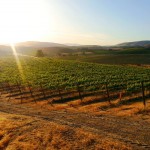
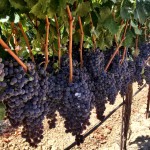
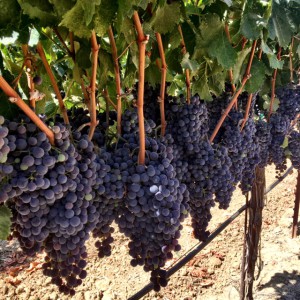

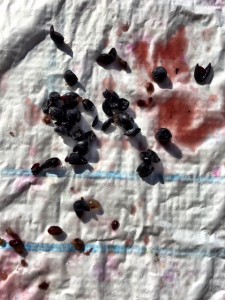
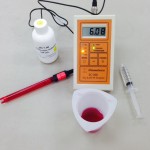
Recent Comments